The curious name of Camelopardalis (actually a giraffe) results from the combination of camel+leopard because giraffes look sort of like camels with leopard spots. Or at least people used to think they did, including a Dutch theologian named Petrus Plancius who invented the constellation in 1613. The giraffe in the Urania’s Mirror chart shown above does not have spots, despite the name, probably because the constellation received perfunctory handling in Alexander Jamieson’s atlas from which it was plagiarized for Urania’s Mirror. Jamieson’s hapless giraffe was divided between two charts and merely sketched in sans spots.
Here is my observing report from Friday evening, February 3, 2023 when Comet ZTF was visiting the large and dim region of Camelopardalis, once sarcastically described by Dalmiro Brocchi, a famed AAVSO chart maker, as the “the absence of a constellation” because its brightest stars are only forth magnitude. Despite its conspicuous lack of conspicuous stars, Camelopardalis has plenty to offer suburban binocular astronomers, enough for many pleasant evenings of observation. Only a small portion of its bounty is recounted here.
I had observed Comet ZTF the previous evening with the Oberwerk 127XL-SD from my driveway. The temps were in the 20s, the winds from 10 to 20 mph, and I nearly froze my tail off. So I was wondering Friday evening if I wanted to repeat that experience. I set up on my front porch instead with the 82XL-SD, a more or less grab and go option, telling myself I would observe for a bit and see how I felt. The porch is sheltered from the wind, which was not as bad Friday evening, but I wasn’t taking any chances.
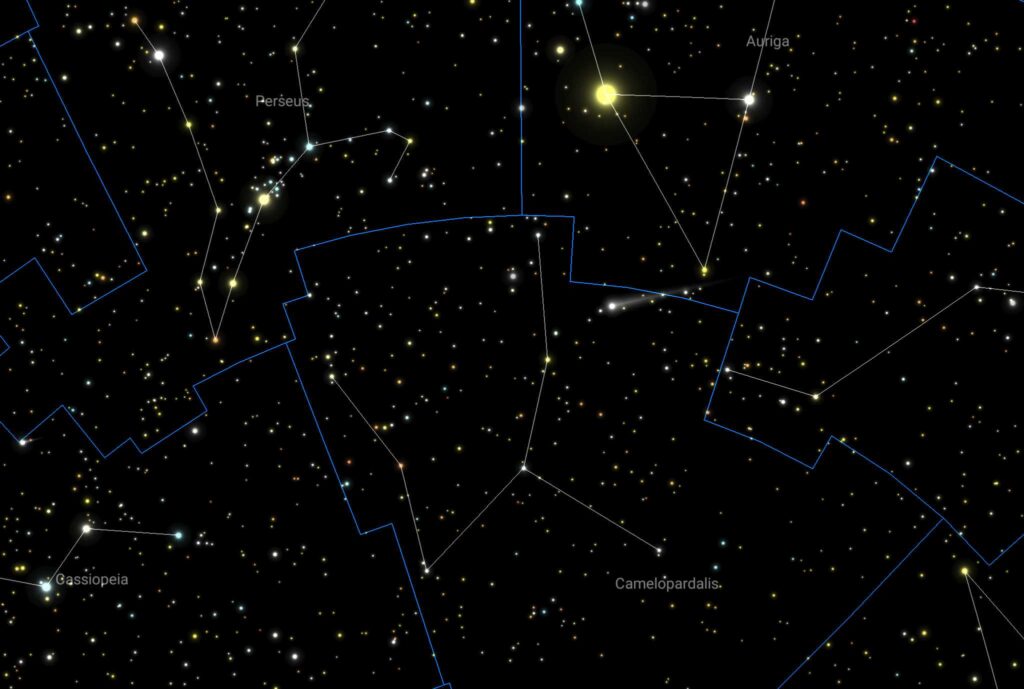
Here is a chart showing the position of comet ZTF in Camelopardalis on Friday evening. North is down and west is left, showing the correct orientation of Perseus, Auriga, and Camelopardalis as seen from my porch facing north. If you were to study this chart carefully comparing it with an accurate map of the constellation, you might discover a few extra “stars,” which are in fact exceedingly dim comets (17-18 magnitude) Sky Safari displays when the Solar System comet option is checked without providing a magnitude limit adjustment (at least in my 6.x version of the app). Despite minor annoyances like this, it is an exceedingly handy observing tool and has thoroughly supplanted the print atlases I used for decades.
I began the session seated in my cheap green camp chair picking out the stars of the main Camelopardalis asterism (indicated by gray lines in the chart) with my Oberwerk 8×32 SE binocular. The camel is upside down, with its hooves near the borders of Perseus and Auriga and its head out of sight near Polaris in Ursa Minor.
Next I looked up Comet ZTF with the 82XL and Pentax 14mm XW eyepieces, which is 32x magnification. The comet was bright and easily seen despite the 97.7% illuminated waxing gibbous moon. I could see a compact core with a broad envelope, but no hint of the tail or greenish color. Not surprising for suburban moonlit skies. It is still a lot of fun to observe. In addition to the 82XL, I picked out the comet with handheld 7x, 8x, and 10x binoculars. It was not difficult to see in averted vision, even with the lower magnification instruments, though it is helpful to know precisely where to look. Here is a rendering of how the comet appeared. The sketch was not made at the eyepiece during the observing session. The background field (made with Sky Safari) accurately depicts the 82XL+14XWs view.
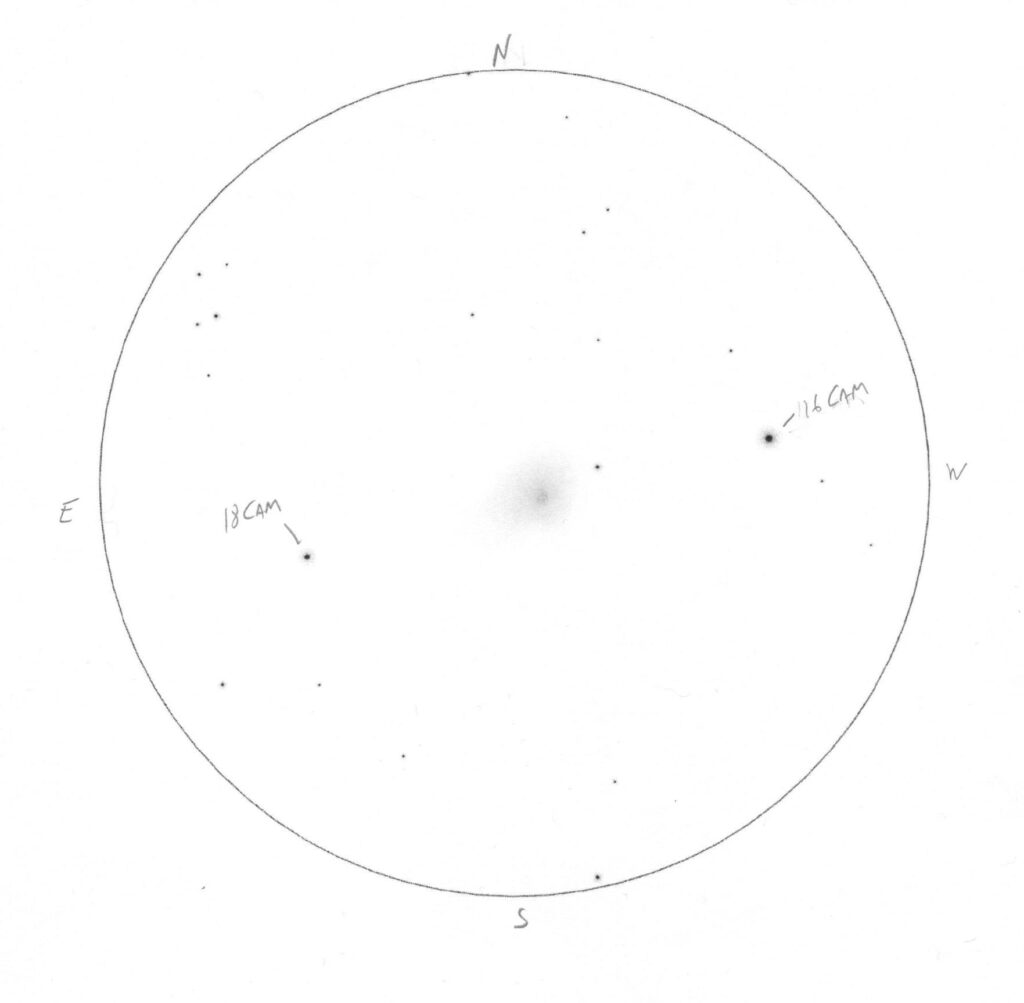
Something that had occurred to me at the end of my Thursday evening session, when I was half frozen, was that I could have noted the position of the comet at the beginning of the session and then checked its position again at the end to see how far it had moved across the sky. So I was ready for that Friday evening. Shown below is the position of the comet when I first observed it at about 7:15 pm and then on the right where it was seen at about 9:15 pm near the end of my observing session. And that was a lot of fun. Again, no sight of that darn tail visually. (But I knew it was there.) 😉
The blue line is the border with Auriga, into which the comet plunged the following day. It was fun watching it cross Auriga over the following evenings.
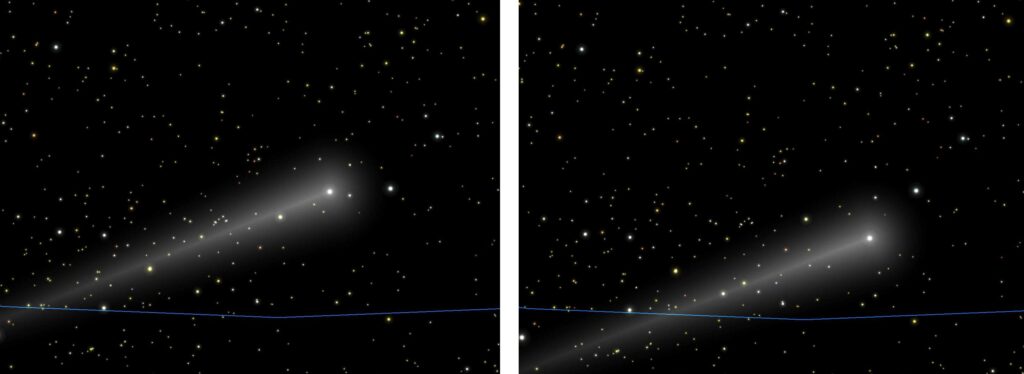
Here are other things I observed, mostly in Camelopardalis.
S 436
03h49m +57*06′
6.46/7.17 58.3″ pa 76*
82XL-SD+14XW (32x) / 8:09 pm
A pleasing double. Both stars bright white, generously spaced. Magnitude difference just detectable. An excellent double for mounted 10x binoculars. A physical double star. Previously reported on Cloudy Nights, 11 November 2021.
The following observations are clustered around the pleasing asterism formed by the 4th magnitude variable stars CS and CE Camelopardalis and a few 5th and 6th magnitude companions. The asterism provides a fine view with 10x (and even smaller binoculars). The image is 6.5 degrees, a typical 10×50 binocular field of view. CS is one of the main stars in the Camelopardalis asterism, which is why the gray line is present in this image, made with Sky Safari. It’s atypical in being a primary star in a constellation and not having a Bayer number or Flamsteed designation. Another sad indicator of indifference and neglect for this overlooked constellation, which probably deserves a support group. Maybe even a fan club? Friends of Camelopardalis? 🤔
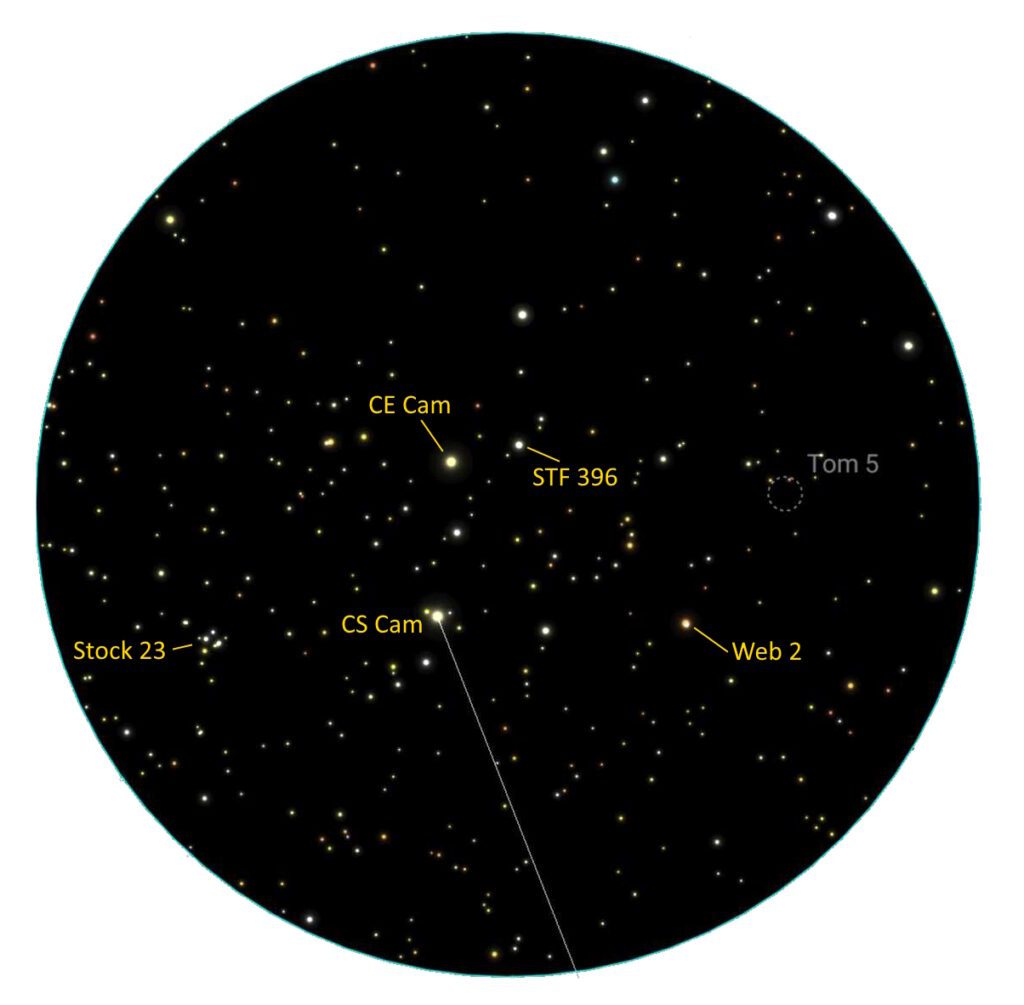
Stock 23
82XL-SD+14XW (32x)
Looking more like a tiny asterism than an open cluster at 32x, Stock 23 (Pazimino’s Cluster) is conspicuous and fun with 10×50 binoculars. One of the brighter stars is actually a fine double star (STF 362) I have been meaning to observe since November 2021. I’m planning to view it in the coming weeks and will post an observation here.
Tom 5 (Tombaugh)
82XL-SD+14XW (32x)
I can’t see anything cluster like here with the 82XL in my light polluted suburban skies. The bright moon not helping! lol Here is an image of the open cluster from simbad.
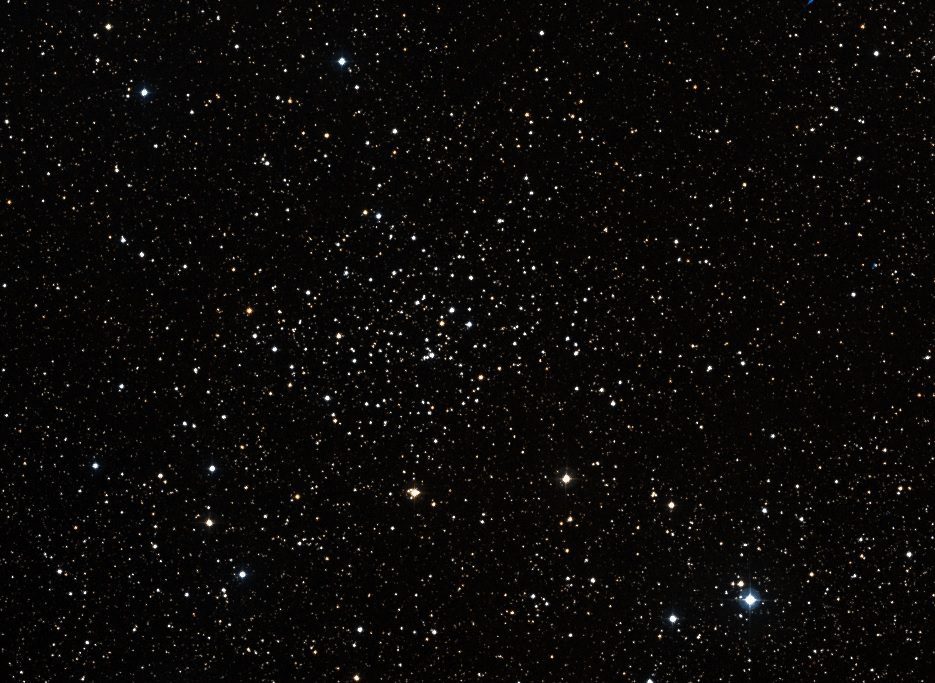
On a better evening (sans moon) with the larger 127XL-SD, it might be possible to detect this cluster. At least something worth a try. And a candidate for my dark sky observing list.
Web 2
03h42m +59*58′
AD 5.72/8.45 54.8″ pa 37*
82XL-SD+14XW (32x) / 8:22 pm
A splendid double. Gold primary with a strikingly cerulean blue companion at a nice distance. Secondary much fainter than primary. Also viewed with 10×56 Maven, Fuji 10×50, 10×70 Resolux, and Maven b.5 15×56. Resolved in all instruments. Best with the Maven and Resolux, but enjoyable with the other 10x binoculars as well.
STF 396
03h33m +58*46′
6.43/7.68 20.5″ pa 245*
82XL-SD+14XW (32x) / 8:57 pm
Another excellent binocular double. Bright white primary with a sand colored secondary nestled together. Tight but fully resolved with the Maven b.5 15×56, colors observable. Physical double star.
Although I have often viewed this fine asterism, this is my first recorded observation of STF 396, probably the first time I have remarked it. Frankly, it is not difficult to detect with 15x binoculars and down right conspicuous at 32x with the 82XL. Noticing it was a fun surprise, and a happy reminder of how rich the night sky is, and how many objects can be found in even a small field of view with careful attention and a bit of research and planning.
STTA 36
03h40m +63*52′
6.92/8.27 45.9″ pa 72*
82XL-SD+14XW (32x) / 9:08 pm
Fun with the 82 and a treat with the 10×70 Resolux. Both stars white. Secondary fainter than primary but still easily seen. Really, a terrific 10x double and adjacent to a bright guide asterism for Kemble’s Cascade. Another case where it is hard to believe I haven’t noticed it before.
Kemble’s Cascade
This is another asterism named for one of it’s discoverers, Fr Lucian Kemble OFM of Alberta, Canada (1922-99) who discovered it with 7×35 binoculars and sent a letter about it to Scott Houston, who promptly named the asterism Kemble’s Cascade and devoted a Deep Sky Wonders column to it in Sky and Telescope magazine. It’s a stream of 20 or so stars leading to the open cluster NGC 1502 and cane be seen with 10×50 binoculars in light polluted skies but is better with 15x instruments.
NGC 1502
82XL-SD+14XWs (32x)
The stand out view of the session. STF 485 dominating, with numerous 9th magnitude stars surrounding, bright and pleasing with the 82XL. It struck me that this is an ideal object for BTs in light polluted skies, combining as it does an excellent double star and a distinct open cluster. I need to have a look at it with the 127XL!
STF 485
04h07m +62*20′
6.91/6.94 18.0″ pa 306*
82XL-SD+14XWs (32x)
Evenly matched white stars. Spectacular with the 82XL. This is getting down to the limit of resolution for a mounted 10x binocular but can still be cleanly resolved. Excellent with 15 and 20x binoculars.
Collinder 463
82XL-SD+14XWs (32x)
Easily navigated to from Gamma Cam and visible with the 82XL as a cluster. Multiple pairs and a few single brighter stars. About 9 total. With fainter members sprinkled among them. A pleasing view though I need to revisit on a darker evening and also from a darker site.
Collinder 464
82XL-SD+14XWs (32x)
When I first observed this cluster in Camelopardalis, in December 2021, I imagined it to be the giraffe’s head, but later realized it is part of the neck. It looks like a bright asterism of five 5th and 6th magnitude stars, which make a pleasing 10×50 view and are handy for navigating the constellation.
STF 618
03h05m +63*05′
7.68/7.98 33.3″ pa 211*
STF 617
05h03m +63*05′
9.24/9.82 12.6″ pa 122*
Physical double star
82XL-SD+14XWs (32x) / 9:25 pm
I wrapped up the session with this splendid duo of double stars, both physical doubles. Was only expecting 618, because 617 did not make the magnitude cutoff on my Sky Safari planning search. 618 is another splendid 10x double. I idiotically did not record color notes in my journal.
Here is my front porch setup for the session, with the 82XL-SD on an Oberwerk TR3 tripod with a carbon fiber elevator and a Manfrotto N608 video head in the foreground, and the 10×70 Resolux on an OB 4000 tripod behind.
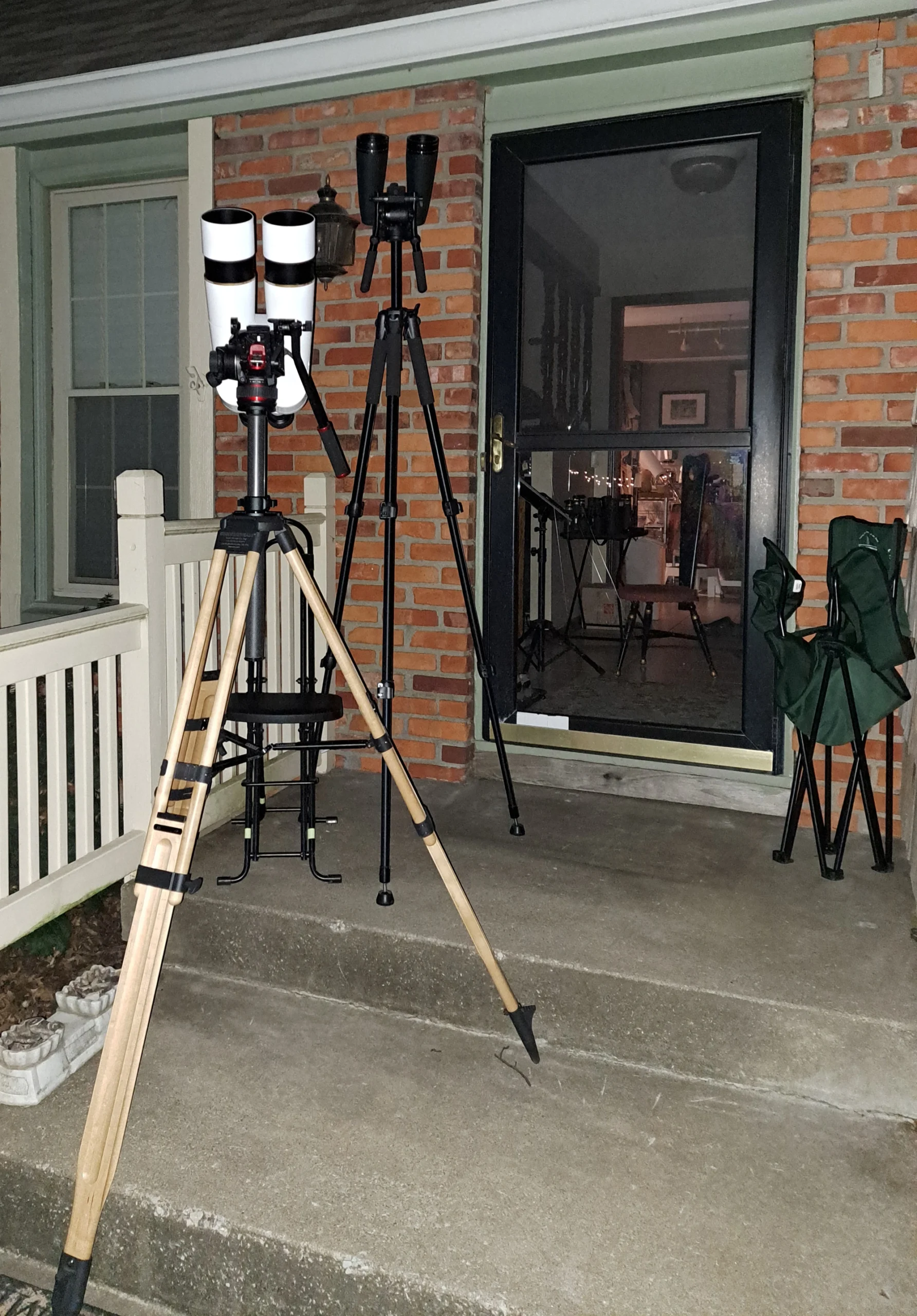
And here is a bevy of binocular beauties, warm and ready in my front hallway. Mostly 10x instruments but also including the Oberwerk 8×32 SE and a Maven b.5 15×56.
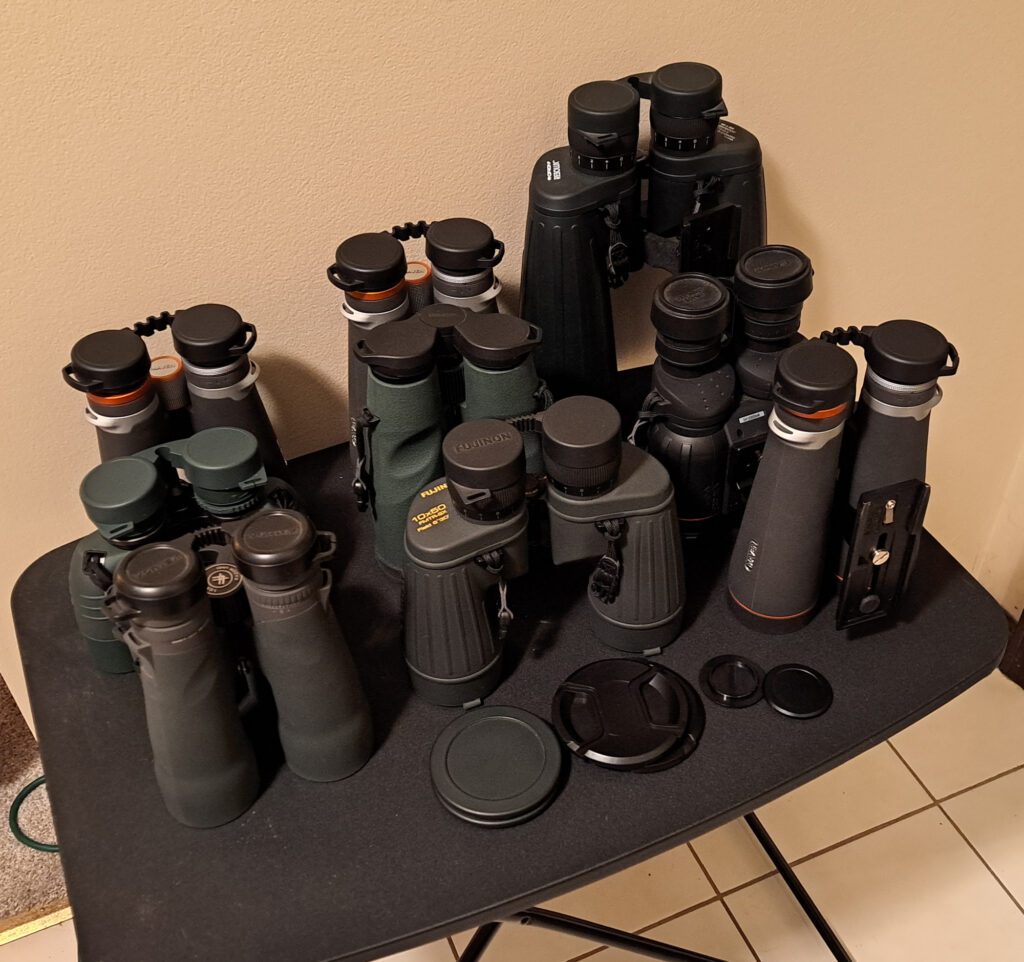


Camelopardalis (how do you even pronounce this) definitely has some nice targets, but I haven’t forgiven it yet for how tough its star-hopping is. The Integral Sign Galaxy (UGC 3697) was worth it in the end, but hopping to it from M81 + M82 wore me out, even with the various NGC galaxy “checkpoints” along the way.
Thankfully binoculars are easier to hop and scan with – provided you have a way to hold them in place while you check your charts.
What doesn’t kill us makes us stronger. 😁
Thanks for your comment, Eric. I am now considering a future post titled “The Cruelty of the Camel.” Unfortunately, it’s actually a giraffe, which doesn’t make so amusing a title. Sigh…